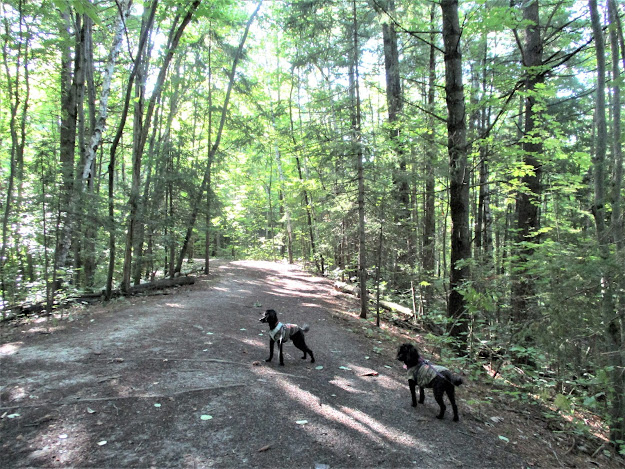As we came close to completing our morning tramp through the woods yesterday morning with Jackie and Jillie towing us along, we heard the sound of saws buzzing ahead as we drew ourselves uphill to access street level. There, in the woods behind the backyard of one of our neighbours, was a municipal crew of arborists busy at work taking down a dead ash that threatened it might fall dangerously close to the trail or into their backyard and onto some poor unfortunate.
In the past few years the emerald ash borer has destroyed the forest inventory of ash trees, as they have throughout eastern Ontario and into the New England states and well beyond. Some of our neighbours who had ash trees growing on their lawns opted to try to save them with insecticidal treatment,but it turned out to be only a temporary fix; the trees continued their fairly swift march to join all those that hadn't been treated.
A few years ago municipal crews were dispatched to cut down dead ash trees that were in vulnerable places where people accessed green areas like our forest and their presence was recognized as dangerous, creating hazardous conditions for people strolling through forest trails or public parks. The crew yesterday took down the tree adjacent our neighbour, and another two alongside the trail leading into the ravine.
The felled trees, cut into sections, were quite aged and consequently large. They were hauled outside the ravine and left just at its cusp where we enter daily. In the hours to follow, people drove by with pick-up tricks and maneuvered some of the quite lengthy and hefty trunk parts onto their trucks and made off with them.Though they could be cut into firewood, it's also likely that people may have taken them to local mills to be cut into boards. It's something our younger son would do, and then proceed to painstakingly make furniture with the wood as a wood craftsman, among his many other interests.
What remains is much too heavy for anyone, even several working together, to lift. The trunks could have been left in the forest to decay and give shelter to insects and animals, but it's likely they'll be lifted mechanically eventually and hauled away. They represent a tremendous weight. Early Canadian 19th century furniture was often constructed of ash. There are commercial furniture makers crafting their wares by hand willing to make use of ash-borer trees for the production of quality furniture.
Today dawned really quite cool at 10C, though sunny. Wind countered the sun, however, and we decided to put light little sweaters on Jackie and Jillie. Small dogs, like people, are sensitive to temperature, and they don't mind wearing garments against the cold. It 's when we have to pull little rubber booties over their paws when we're into sub-zero temperatures and deep in snow that they'll evince an initial sense of bewilderment.
Our daily trips through the forest continue to entertain us with seasonal sights. In the spring and through the summer months it's a succession of wildflowers. Now that fall weather is intruding on our idyll, there are far fewer flowers and the wild berries are almost exhausted. What attracts our attention now is the various types of fungi that show up on decaying branches and tree trunks.
And even more so, a variety of mushrooms that have a tendency to suddenly pop up overnight on the forest floor. We've come across some that are stark white, and others that are light tan. Some are a considerable size, and some are minuscule, extending in a straight line as though someone had carefully poured them onto the ground. During the summer we'd often come across fungi with indistinguishable shapes, just splotches of bright orange in appearance, resembling cast-off orange peel.
Now, the most interesting we've come across have been the symmetrical-shaped traditional-in-appearance toadstools, some of which are of a considerable size, their colouration butter-yellow, with little 'bumps' scattered over their caps. Squirrels are curious little mischief-makers, attracted to anything in their habitat that might be fodder for their appetites. Some mushrooms are nibbled in one discreet area and left; clearly a reject. While others can be nibbled all the way around, and we conjecture those are the ones that meet the gustatory approval of the squirrels' taste buds.
Although while we're in the ravine on the forest trails there's never any need for sunglasses, since we're continually in the shade, courtesy of the forest canopy which allows sunlight to streak through the trees randomly but seldom covering much ground level areas, once we reach street level as we make our way back home again, the piercing sun floating through an azure sky in its new, fall trajectory becomes almost blinding in the ferocity of its glare.
Wandering briefly through the garden one can barely make out the discrete landscapes, everything is so dazzlingly bright. We might as well enjoy it in full measure. As it is it seems unbelievable that summer is coming to an end, for it seems to have zipped by so quickly we can barely credit that summer is on the cusp of exiting 2020.






No comments:
Post a Comment